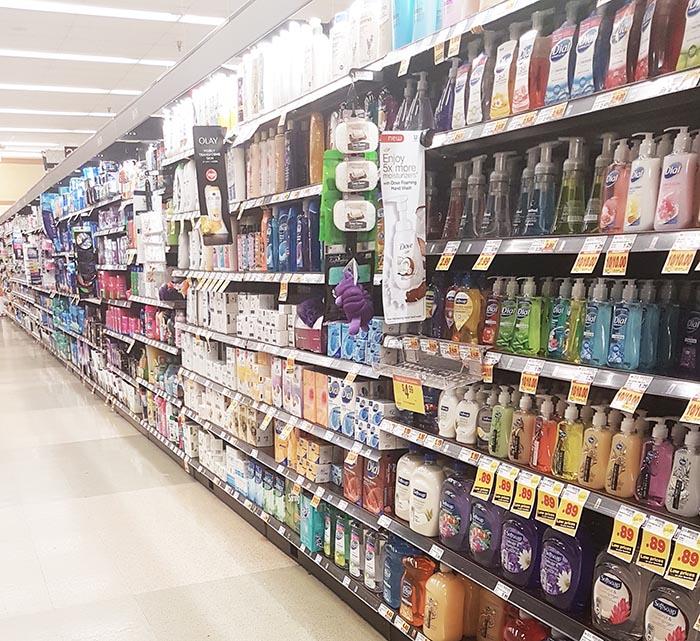The perils of supermarket hair products!
by Ella Levy, House of Lox Sydney, Senior Hair Stylist
We’ve all heard the stories on supermarket brands and the problems they can cause for your hair.
But have you ever wondered exactly what the real issues are and why?
Or perhaps you’ve experienced firsthand an issue with treated hair not working out as expected due to contamination from non-professional products. When it comes to the perfect balayage or clean foils have you ever felt like you just can’t get blonde enough? Well it might not be your hairdresser who is the culprit, but your aftercare, bought from the supermarkets.
You’ve probably heard your hairdresser rant about how bad these shampoos and conditioners are, and some may think this is just a sales pitch to get you to buy their products. The truth however, is cheap shampoos and conditioners are often not designed to be compatible with chemical hair treatment processes, and in the worst cases can actually cause quite serious chemical reactions and damage to your hair – not what you want at all!
What to look for (and avoid) in your supermarket hair products.
So, what is in your supermarket hair products?
So to set the record straight we thought we would run through what actually is in some of these shampoos and conditioners that can be causing long term damage/issues for your hair, so you can be aware and avoid them:
Over the long term this slowly cause more problems for your hair as these nasty silicones build up over time slowly coating the hair and preventing colour, bleach and good shampoos/conditioners from penetrating, meaning that even when you try your hardest you may find that hair will take a few times to lift/colour and/or have a uneven/ inconsistent tone to them. This will be caused by the hair shaft not opening as the hair is highly coated in these chemicals.
However that is not all the bad news – often these silicones can cause a chemical reaction with bleach whilst being treated, which can cause the product to heat and slip right off the hair. The heat can also cause serious damage to the hear, potentially causing it to break and leaving you with short and badly damaged hair instead of the long luscious blonde locks you were hoping for.
We all love how our hair feels and looks after a swim at the beach but know how damaging it can be, such as damage to the cuticle, knotty ends, sun damage (lightening). If you swim a lot, a long-term build up can occur and leave the hair very brittle. So naturally the same affect can arise from using shampoo and conditioner with this product in it, so it can become a risk trying to colour/bleach when hair is quite damaged and brittle as the chance of snapping increases… avoid this ingredient as much as possible. Also look at sea salt sprays etc as they may have this ingredient too.
So we’ve all heard of natural keratin in our hair right? Well these two ingredients are the main cause of keratin disintegrating.
We all need natural keratin in our hair as it controls the health of the hair shaft and how strong our strands of individual hair is, so without this our hair is shattered and weak. And well, what do we need when lightening our hair? Strong hair… it is essential to avoid these ingredients.
The more ammonia the more the hair shaft opens to let colour penetrate into the hair rather than just coating the hair. Ammonium is a foaming agent found in shampoos to help lather the hair. Also opening the cuticle which can cause some damage by the hair knotting etc. this also can affect the hair when being bleached then as by the cuticle being opened/damaged the colour can penetrate faster leading to unwanted warmth and an uneven blonde. This also means with a faster lift that you could find finer areas of your hair could snap. It can also cause issues with sensitive scalps possibly leading to irritant rashes and scalp break outs.
Please make sure to always read the label as when mixed with alcohol or citric acid this can cause an affect in the same way using lemon to lighten your hair would. It can lead to unwanted fading or uneven colour lift… always avoid a product if ammonium is within the first five ingredients.
So please, if you are thinking of going blonde, or are blonde get rid of these nasty products asap! And speak with your hairdresser about what to use.
Above all, always be completely honest with your hairdresser about your product history. If you have been using supermarket shampoos and you tell them, they can perform a deep cleanse before any colour treatment processes which can cleanse away some of the build-up and alleviate any issues. It is far less embarrassing to discuss this up-front, than to come clean later when you have a full head of foils fizzing and dripping all over you from a chemical reaction!

